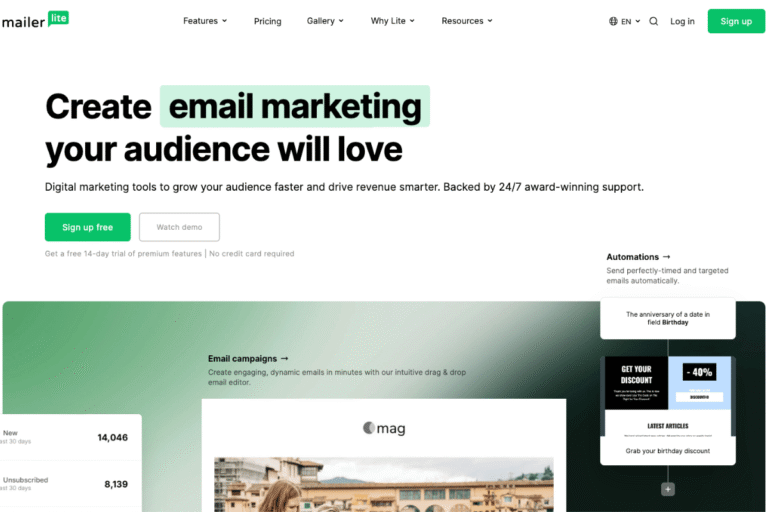If you’re sending email without A/B testing, you’re guessing. With a few structured experiments, you can raise open rates, double click-throughs, and make the same list generate more revenue, without burning subscribers. This tutorial shows you exactly how to run A/B testing in email marketing, from choosing what to test to rolling out winners. You’ll get practical steps for MailerLite, Mailchimp, and ConvertKit, plus real examples you can copy today. Let’s make your next send measurably better.
What A/B Testing Is And When To Use It
A/B testing (a.k.a. split testing) is the practice of sending two or more versions of an email to similar audiences to learn which drives a better outcome. You might test subject lines, CTAs, send times, or content, then roll out the winner to the rest of your list.
The value: it replaces hunches with evidence. Instead of arguing “short subject lines work best,” you’ll know what works for your audience. Use email A/B testing to validate high-impact decisions that affect opens, clicks, conversions, or revenue.
When to test:
- You have a clear hypothesis and a single variable to isolate.
- The audience is large enough to reach significance (more on that below).
- The outcome matters (e.g., product launch, promo, major newsletter).
- You can act on the result (winners roll out quickly).
Split Tests Vs. Multivariate Vs. Holdout
- Split (A/B or A/B/C): Test one element at a time (e.g., two subject lines). Best for most small businesses.
- Multivariate: Test multiple elements and their interactions (e.g., headline + CTA + image). Requires large lists and careful design.
- Holdout/control group: For ongoing programs, reserve a small portion that gets no promotional treatment. Compare revenue to measure true incremental lift.
When Not To Test
Skip testing when:
- Your list is too small to detect a meaningful difference (e.g., <1,000 recipients) and the change is subtle.
- You can’t isolate the variable (e.g., changing copy, design, and offer at once).
- The stakes are low (a routine, low-impact send) or you can’t carry out the winner in time.
- You’re tempted to “peek” and stop early, this inflates false positives.
Choose What To Test: High-Impact Elements
Not all tests are equal. Prioritize variables most likely to move your primary metric.
Subject Lines And Preview Text
- Impact: High on open rate. Preview text supports the subject like a subtitle.
- What to try: Curiosity vs. clarity, benefit-led lines, numbers, urgency, personalization, emojis (sparingly), length (30–60 characters), question vs. statement.
- Tip: Pair subject and preview deliberately, don’t repeat: complement.
From Name And Sender Reputation
- Impact: Trust drives opens. “Brand + First Name” often feels personal without being vague (e.g., “Jules at CoffeeCo”).
- What to try: Brand vs. person, consistent domain, authenticated sending (SPF/DKIM/DMARC) to support deliverability.
- Caveat: Don’t change From Name too often: consistency builds recognition.
Email Content: Offer, Copy, CTAs, And Layout
- Impact: Highest on clicks and conversions.
- What to try: One vs. multiple CTAs, button copy (“Get 20% off” vs. “Shop the collection”), product vs. story-first layouts, social proof, hero image vs. gif, long vs. short copy.
- Tip: Make the winning CTA a playbook, reuse the phrasing that lifts CTR.
Timing And Frequency
- Impact: Medium to high depending on audience behavior.
- What to try: Morning vs. afternoon, weekday vs. weekend, send-time optimization (STO), cadence (weekly vs. biweekly).
- Note: Seasonality matters: revalidate periodically.
Audience Segments And Personalization
- Impact: Very high on conversions. Testing who gets what often beats creative tweaks.
- What to try: Segment by lifecycle stage (subscriber, customer, lapsed), interest tags, past purchases, location/timezone. Personalize offers or content blocks for relevance.
- Guardrail: Don’t over-personalize with sensitive data: keep it helpful, not creepy.
Define Success: Metrics And Statistical Basics
Clarity upfront prevents muddy conclusions.
Primary Vs. Secondary Metrics (Open Rate, CTR, CVR, Revenue)
- Primary: Choose one outcome your test is designed to move. Examples:
- Subject line tests → Open rate.
- CTA or layout tests → Click-through rate (CTR).
- Offer tests → Conversion rate (CVR) or revenue per recipient (RPR).
- Secondary: Keep an eye on unsubscribes, spam complaints, bounce rate, time on site, AOV. A “winner” that spikes spam isn’t a winner.
Sample Size, Power, And Test Duration
- Sample size: Enough recipients per variant to detect a practical difference. As a rough rule: aim for at least 1,000 recipients per variant for subject lines, 2,000+ for click/conversion tests. Smaller lists can still learn, just test bigger differences.
- Power: The probability of detecting a true effect. Most ESPs assume 80% power: higher power needs larger samples.
- Duration: Keep tests within a fixed window (e.g., 4–24 hours for subject lines, 24–72 hours for click/conversions). Let stragglers click, but define the cutoff in advance.
Significance, Confidence, And False Positives
- Significance level (alpha): Commonly 0.05 (5%). If the p-value is below this, the result is unlikely due to chance.
- Confidence level: Often presented as “95% confidence.” Don’t treat 94% vs. 96% as night and day, look at the magnitude of lift and business impact.
- Multiple testing: If you run many tests, expect occasional false winners. Confirm big wins with a follow-up replication, especially before changing evergreen automations.
Plan And Set Up Your Test
Great tests start with crisp hypotheses and controlled execution.
Write A Clear Hypothesis And Isolate Variables
Use the format: “If we [change X], [Y metric] will improve because [reason].” Example:
- “If we add social proof to the product block, CTR will increase because readers trust peer validation.”
Keep everything else constant. One variable per test.
Create Control And Variations With Guardrails
- Control: Your current best practice.
- Variant(s): One change each (A/B or A/B/C). Avoid testing three or more variants unless you have the list size.
- Guardrails: Pre-set limits on spam complaints (<0.1%), unsubscribe rate (<0.5–1%), and deliverability (bounce rate). If breached, stop and analyze.
Set Up In MailerLite
MailerLite makes A/B testing straightforward for campaigns.
- Create campaign → A/B split test.
- Choose variable: Subject line, From Name, or Email content.
- Audience split: Select sample size for variants (e.g., 20% A, 20% B) and remainder for the winner.
- Winner criteria: Opens for subject tests, clicks for content tests. Set evaluation time window (e.g., 4–12 hours).
- Build emails: Keep all else identical. Use the drag-and-drop editor: label blocks clearly.
- Review and schedule: Enable timezone-based delivery if relevant.
Pros: Clean UI, visual reports, budget-friendly. Cons: Fewer advanced multivariate options. Pricing (as of writing): Free tier for smaller lists with limits: paid “Growing/Advanced” tiers typically start around low two digits per month, check MailerLite’s pricing page for current details. Ready to try it? Start with MailerLite and run your first test today.
Set Up In Mailchimp
Mailchimp supports A/B and multivariate (on higher plans).
- Create campaign → A/B Test.
- Choose variable: Subject line, From Name, Send time, or Content.
- Select variants: Up to 3 for A/B: multivariate (subject + content + send time) on eligible plans.
- Define sample and winner metric: Opens, clicks, or revenue (if e‑commerce tracking is enabled).
- Build content: Use the same template: only change the tested element.
- Schedule and send: Pick evaluation time (e.g., 4–24 hours). Mailchimp auto-sends the winner to the remainder.
Pros: Robust analytics, STO, commerce reports. Cons: Costs can rise with list size: advanced testing may require higher tiers. Pricing (as of writing): Essentials/Standard/Premium tiers: entry typically in the teens per month for small lists. Compare plans on Mailchimp’s site. Want to explore? Try Mailchimp and set up a quick subject test.
Set Up In ConvertKit
ConvertKit emphasizes creator-friendly testing.
- Broadcast → A/B Test (subject line testing native: content tests via duplicate emails to segments).
- For subject lines: Enter A and B directly in the subject field split tool.
- Choose split size: Commonly 15–30% of the list for testing, winner to the rest after a defined window.
- For content tests: Duplicate the email, adjust the single variable, and send to randomized splits or tags.
- Track outcomes: Use link click reports and Commerce conversions if you sell with ConvertKit.
Pros: Simple interface, great for creators, visual automations. Cons: Limited built-in content A/B in broadcasts: you may need manual splits. Pricing (as of writing): Free for starting lists with limited features: Creator plans typically start in the low two digits monthly. Get rolling with ConvertKit and test your next headline.
Execute And Monitor Without Bias
Small execution tweaks can make or break validity.
Randomization, Even Splits, And Send Windows
- Randomize recipients so each variant represents your audience fairly. Use your ESP’s random split: avoid segmenting by convenience (e.g., A to last week’s signups, B to veterans).
- Even splits: 50/50 for A/B unless you’re using a test-and-roll approach (e.g., 20/20/60 where 60% gets the winner).
- Fixed windows: Decide evaluation windows in advance. Don’t move goalposts when early results look exciting.
Deliverability, List Hygiene, and Accessibility
- Authenticate your domain (SPF/DKIM/DMARC) and warm new sending domains gradually.
- Clean your list: Suppress hard bounces, prune inactive subscribers periodically, and avoid spam traps.
- Accessibility: Use sufficient color contrast, real text on buttons, descriptive link text, and alt text on images.
Mobile-First Rendering And Load Speed
- More than half of opens are mobile. Use single-column layouts, tappable buttons (44px+), and compressed images.
- Host heavy assets on CDNs, lazy-load gifs when possible, and keep total email weight under ~100KB for faster loads.
Analyze Results And Decide What To Roll Out
When the window closes, move from “interesting” to “actionable.”
Reading Reports, Confidence Levels, And Lift
- Look for: primary metric lift (absolute and relative), confidence, sample size, and guardrail metrics.
- Example: Variant B open rate 38% vs. A 32% = +6 points (18.8% relative lift). If confidence ≥95% and spam/unsubs steady, B wins.
- Consider magnitude: A tiny but significant lift may not justify operational change: a moderate lift that’s directionally consistent across segments often will.
Segment-Level Insights And Revenue Impact
- Break out results by device, geo, lifecycle stage, and acquisition source. A subject line that wins with new subscribers may underperform with long-time readers.
- Tie to revenue where possible: revenue per recipient (RPR) or per thousand (RPM). A “lower open, higher revenue” outcome can still be your winner if revenue is primary.
Document Learnings And Plan Follow-Up Tests
- Log: hypothesis, variants, audience, dates, metrics, outcome, and key screenshots.
- Promote winners to templates/automations.
- Queue a follow-up: confirm big wins or iterate (e.g., after a CTA win, test button placement next).
Example Walkthroughs You Can Replicate
Use these plug-and-play scenarios to start.
Subject Line Test For A Product Launch
- Hypothesis: “Benefit-led subjects will drive higher opens than curiosity-led ones.”
- Variants: A) “Meet the mug that keeps coffee hot for 6 hours” vs. B) “Finally, a mug that fixes the 3pm slump.”
- Audience: 20% A, 20% B: winner to remaining 60%.
- Metric: Open rate: window 6 hours.
- Outcome to look for: If A wins, make benefit-first your default for launches. Follow-up: test adding a number or social proof in preview text.
CTA Copy And Button Color For A Newsletter
- Hypothesis: “Specific CTA copy will lift CTR more than color.”
- Design: Keep layout identical. Test A) Button copy “Read the full guide (7 min)” in brand color vs. B) Same copy, contrasting color vs. C) Vague copy “Learn more” in brand color.
- Metric: CTR: window 24–48 hours.
- Decision rule: If A ~ B but both beat C, copy matters more than color. Bake the winning phrasing into your template.
Send Time Optimization For A Weekly Campaign
- Hypothesis: “Tuesday 10am local time will beat Sunday 7pm for B2B.”
- Approach: A/B across 2 consecutive weeks or use STO to split within the same week.
- Metric: Opens and downstream clicks.
- Twist: Check device split, mobile-heavy audiences may prefer evenings: desktop-heavy might favor mornings. Revalidate quarterly.
Build A Sustainable Testing Program
Treat testing like a product, not a one-off experiment.
Prioritization Roadmap And Test Cadence
- Maintain a backlog ranked by expected impact × ease × confidence.
- Cadence: 1–2 tests per week for active newsletters: 1 test per month for smaller lists. Avoid overlapping tests targeting the same audience on the same day.
- Themes: Rotate across subject, content, offer, and audience to avoid tunnel vision.
Ethical Considerations, Compliance, And User Respect
- Be transparent and respectful: no deceptive subjects or fake “RE:” tricks.
- Honor unsubscribe and preference centers: comply with CAN-SPAM/GDPR/CCPA.
- Don’t over-test the same users with frequent conflicting variants, fatigue is real.
From One-Off Wins To Repeatable Playbooks
- Turn winners into standards: a “house style” for subjects, CTA library, design system components.
- Create a wiki or Notion page with do’s/don’ts, sample sizes, and past results.
- Automations: Periodically re-test key nodes (welcome subject, promo CTAs) as your audience evolves.
Ready to operationalize? Pick your stack and start small: a subject line test this week, a CTA test next week. If you need an ESP, try one of these solid options: MailerLite, Mailchimp, or ConvertKit.
Conclusion
A/B testing in email marketing isn’t about being clever, it’s about being consistently right. Start with a clear hypothesis, test one high-impact variable at a time, and measure what actually matters to your business. Use your ESP’s built-in tools to automate splits, set sensible windows, and let the data decide. Then turn wins into habits.
Want a nudge to get going? Spin up a 15‑minute subject line test in your tool of choice: Launch MailerLite, Set up Mailchimp, or Try ConvertKit. Your list doesn’t need to grow to drive more sales, your emails just need to get better, one test at a time.
Frequently Asked Questions
What is A/B testing in email marketing and when should I use it?
A/B testing in email marketing compares two or more versions of an email with similar audiences to see which drives a better outcome. Use it when you have a clear hypothesis, one variable to isolate, enough recipients to reach significance, the outcome matters, and you can roll out the winner quickly.
What should I test first to boost opens and clicks?
Prioritize high-impact elements. For opens: subject lines and preview text—try benefit-led vs. curiosity, numbers, personalization, and 30–60 character lengths. For clicks: CTA copy and placement, single vs. multiple buttons, product vs. story-first layouts, and social proof. Keep everything else constant and make winners your new defaults.
How big should my sample be and how long should an email A/B test run?
As a rule of thumb, aim for about 1,000 recipients per variant for subject line tests and 2,000+ for click or conversion tests. Define fixed windows: 4–24 hours for subjects; 24–72 hours for click/conversion tests. Most ESPs assume 80% power—avoid peeking early to reduce false positives.
What lift can I realistically expect from A/B testing in email marketing?
Results vary by list size, offer, and test quality. Well-designed subject tests often yield 5–20% relative open-rate lifts; strong CTA or offer changes can deliver 10–30% relative click lifts. Not every test wins—treat big gains as provisional and replicate before updating evergreen templates or automations.
Is A/B testing in email marketing compliant with GDPR/CCPA, and how do I stay ethical?
Yes, if you have a lawful basis (consent or legitimate interest) to email users and honor rights. Avoid deceptive subjects, respect unsubscribe/preferences, and don’t over-personalize with sensitive data. Monitor guardrails: keep spam complaints under ~0.1% and unsubscribes under ~0.5–1%. Authenticate your domain to protect deliverability.


